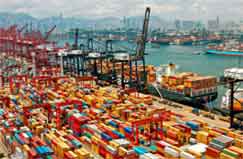| |
|
| |
|
 |
Supply
Chain by the Numbers |
| |
|
| |
- Nov. 10, 2022
|
| |
|
| |
|
| |
|
| |
NRF with Holiday Sales Projections; No Talks for Months on West Coast Dockworkers Contract; Chinese Producer Prices Falling; Container Shipping Rates Headed below Pre-Pandemic Levels |
| |
|
| |
| t |
| ac |
| |
6-8% |
|
That is the prediction for 2022 holiday retail sales growth, according to the National Retail Federation forecast this week. That compares with a blistering 13.5% growth seen a year ago. The group expects that online and other non-store sales, which are included in the total, will increase between 10% and 12%. We note inflation can pump up sales even if people are buying less, and with prices surging to uncomfortable levels, industry analysts believe that inflation-adjusted sales could be flat, or even negative this year. Holiday sales have risen an average of 4.9% over the past 10 years. |
|
|
|
| |
| |
|
|
|
| That was the drop in prices charged by Chinese companies at the factory gate in October, according to China’s National Bureau of Statistics this week. That made it China’s first year-over-year decline in producer price inflation since December 2020. While this may be good news on the inflation front, it is also a symptom of a slowing global economy. The news of a fall in prices comes right after China released data showing its exports to the rest of the world shrank unexpectedly in October, a sign that global trade is contracting. The Chinese data showed also showed exports to the US fell 13% year-over-year in last month. Economists say high retail inventory levels, worried consumers and high inflation in the West have reduced demand for Chinese imports. Many economists expect a recession in the US within the next 12 months. |
|
|
|
| |
| |
$2087 |
 |
That was the approximate spot market rate to ship a 40-foot container from China to the US West Coast last week, according to the Loadstar.com web site. That puts container spot on course to dip below pre-pandemic levels before the end of the year. The problem: ocean carriers’ operating costs are significantly higher than they were in 2019, which could force some carriers back into the red in the first quarter of 2023, after two years of soaring rates and record profits. As usual, falling demand is the key factor, just as soaring volumes plus smart capacity management by carriers were behind the record rates. Maersk recently reported, for example, that its Q3 container volumes fell 7.6% versus the same quarter in 2022. The port of Los Angeles said last week its volumes were down 26% versus the same week in 2020-2021. |
| |
| |
| |
| |
| |
|
|
|
| |
 |
 |
| |
 |
![]() |
 |
|
| |
 |
Feedback |
|
|
|
![]()
|
No Feedback on this article yet.
|
|
![]() |
|
|
|
![]() |
 |
![]() |
 |
|
| |